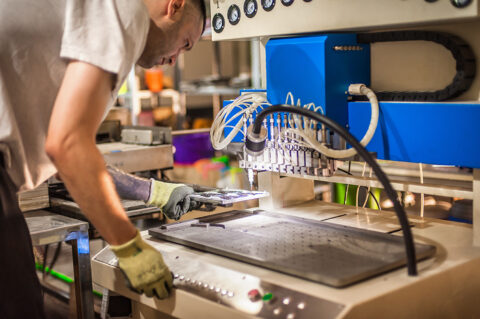U.S. manufacturing in July 2025 stood its ground under pressure, navigating tariff-driven costs, weakening new orders, and contracting employment. Both major PMIs fell below the 50 mark, signaling broad-based contraction. Yet amid the near-term softness, the strategic posture of the sector is unmistakable: companies are protecting core capabilities, doubling down on domestic investments, and reinforcing the supplier relationships that define American manufacturing.
This is the pattern of a long game—not a retreat. The numbers show short-term strain, but the moves behind the scenes point toward a resilient, distributed industrial base preparing for the next wave of opportunity.
A Month in Manufacturing Data
Perspectives from ISM Report
The Institute for Supply Management reported its fifth straight month of contraction, with the ISM Manufacturing PMI dropping to 48.0% in July (from 49.0% in June)—the fastest pace of decline since October 2024.
Demand indicators were the weak link. The New Orders Index stayed in deep contraction at 46.4%, and order backlogs shrank further. The Employment Index fell sharply to 43.4%, signaling accelerated cuts to factory payrolls.
Production, however, moved into expansion territory, with the Production Index rising to 51.4%. It’s a reminder that even in a downcycle, U.S. manufacturers are still getting after it—completing orders, keeping machines running, and leaning on trusted suppliers to deliver.
Insights from S&P Global PMI
S&P Global’s U.S. Manufacturing PMI echoed the contraction signal, registering 49.8 in July—its first sub-50 reading of 2025, down from 52.9 in June. A flash estimate earlier in the month came in at 49.5, a seven-month low.
Survey responses cited cooling domestic and export demand, with many customers pausing orders after stockpiling ahead of tariff deadlines earlier in the year. Output stalled, backlogs fell, and hiring slowed to a halt. While cost inflation eased modestly, tariffs continued to shape pricing decisions and sourcing strategies.
The takeaway: after months of pulling demand forward, the sector is now in a recalibration phase.
What the Data Means
With both PMI measures in contraction, July underscores that this is not a uniform downturn—it’s a patchwork. Some grid squares are still in the fight, with production ticking up and certain sectors holding demand, while others are in a tactical pause, conserving resources until the next clear signal.
The contraction in new orders is a critical data point. In a deeply relational industry, fewer orders ripple through networks quickly—affecting shop floor hours, supplier commitments, and hiring plans. But this doesn’t signal collapse. The American model—thousands of small and medium-sized businesses working in concert—remains intact and capable. The challenge is to keep those connections strong while the market resets.
Major New Factory and Expansion Announcements
Even as headline indicators softened, July saw significant moves by industry leaders reaffirming their commitment to U.S. manufacturing capacity:
Hadrian Launches AI-Powered Factory Hub in Arizona
Advanced manufacturing firm Hadrian announced a new $200 million AI-enabled factory and software hub—known as “Factory 3”—in Mesa, Arizona. The 270,000-square-foot facility will support mission-critical systems and create 350-plus new jobs. To support this expansion, the firm announced $260 million in new capital, doubling down on its “Factories-as-a-Service” model to deliver complete production stacks—from raw material through finished platforms.
Mars Opens $240 Million Nature’s Bakery Facility in Utah
Mars, Inc. unveiled a new $240 million LEED-Silver certified bakery facility in Salt Lake City for its Nature’s Bakery brand. The 339,000-square-foot plant is designed to produce over one billion snack bars annually, create 230 new jobs, and reduce trucking-related CO₂ emissions by 5,700 metric tons—evidence that industrial growth and sustainability can advance hand in hand.
Fastenal’s Strong Sales Momentum
Fastenal beat earnings expectations with Q2 EPS of $0.29 and 9% year-over-year revenue growth. June daily sales rose, signaling steady demand across a diverse base of industrial customers.
GM’s $4 Billion U.S. Manufacturing Push
Despite a 35% Q2 profit drop (~$1.89B) and $1.1B in tariff impacts, GM announced $4B in new U.S. manufacturing investments. The goal: offset a third of tariff costs and deepen domestic supply resilience.
These investments underscore a strategic truth: even when demand softens, American manufacturers are investing in capacity, relationships, and resilience. That’s the networked entrepreneurship model at work—strengthening local capacity one facility at a time.
Future Outlook
The manufacturing grid is in a temporary holding pattern. Near-term, demand softness and tariff uncertainty will continue to weigh on order books. But the fundamentals for a long-term resurgence remain: billions in committed capital projects, maturing reshoring momentum, and the unmatched adaptability of the 99% of U.S. manufacturers who run small and medium-sized operations.
As we enter what may be the second inning of a 20–30 year reshoring shift, the mission is clear: keep the network strong, keep the connections alive, and keep investing in capacity that can respond when demand turns. This isn’t just an economic strategy—it’s a matter of national readiness.
In the months ahead, watch for policy clarity on trade, the ramp-up of recently announced facilities, and the role of technology that strengthens—not replaces—the relationships that make manufacturing a team sport done in community. July was a reminder: the fight for American industrial strength is ongoing, and we are very much still in it.




